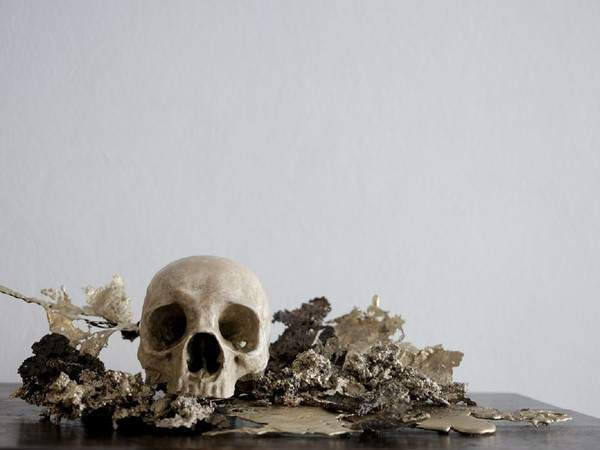Memento Vivere: in Pietrasanta, the exhibition of Valentina Lucarini Orejon
From Aug. 20 to Sept. 10, 2022, Ponzetta Gallery in Pietrasanta is hosting the solo exhibition Memento Vivere by Tuscan sculptor Valentina Lucarini Orejon (Pietrasanta, 1985). The artist, in her research on relics and votive offerings, is presenting a new series of works: four patinated bronze sculptures, two skulls and two femurs, with superimpositions and interventions in additional metals, from brass to white bronze as well as installations with white patinated plaster skulls decorated with bronze and brass slags and “burrs,” so as to want to recreate a sort of Wunderkammer.
As the artist herself states in the text accompanying the exhibition, “For a long time man has lived in close contact with death. Beginning in antiquity, the return to the earth after life was thought to be a cathartic moment, to be accompanied by rituals of sacrifice (from the Latin sacrificium: to make sacred), so as to ward off the cloak of darkness and oblivion that characterize this common fate of ours. Some examples of this are the Mesoamerican cultures of the Maya and Aztecs, later assimilated into today’s Mexican culture, or the Egyptian funerary culture or even the one closest to us belonging to the Etruscans. In Western society, death appears as purged, dissolved, concealed but at the same time commodified properly on social networks, which put words and values such as progress, efficiency and capital in the first place, thus excluding the concepts of fragility, weakness and old age, since they are less attractive and functional. Death thus becomes a mere consumer object of our today’s capitalized collectivity, ascribable to crime news, redundant headlines and ideological wars. From this concealment of death it is probable and possible that to be born, to grow and to stratify is a nonlife; a suspended nonplace, where man does not perceive vital and primary drives and thus tends to retreat into himself. The memento mori or vanitas, comes from the Latin locution that arose within the civilization of ancient Rome, and was apt to remind us to keep our gaze on our present, to enjoy life by setting aside pride, and it is through this message that man returns to the realization of his own finiteness. To live fully, in fact, requires the act of becoming aware; this term renders infinitely well the awe and horror typical of an awakening in unison of mind, heart and soul, an awakening that reminds us that the ephemeral condition of existence-apparently due to the transience of the matter of which we are composed-cannot do anything against the dark, incorporeal force of our souls. Transforming the memento mori into an act of collective art is the intent of this performance, an act that is accomplished through the synergy between two individuals whose synchronous gestures result in a drawn narrative, made up of signs that will go to cover a human skull, a symbolic representation of a common fate. The face-to-face drawing, taken from a game I used to play with my sister as a child, becomes the ritual gesture with which to reappropriate a new narrative of death and consequently of life.”
Valentina Lucarini Orejon, class of 1985, was born in Pietrasanta to an Italian father and Spanish mother. A child of art, born into a family of foundrymen, she grew up surrounded by the most capable sculptors and artisans. After graduating from the“Stagio Stagi” State Institute of Art and graduating from theAcademy of Fine Arts in Carrara - with a thesis on the casting techniques of large equestrian-themed monuments - to enrich her cultural background, she attended the studios of some of the most important artists on the contemporary scene. A student of sculptor Franco Franchi during her academic years, she later followed the teachings of artist and esteemed friend Riccardo Bremer. In her private atelier nestled in the mountains of Versilia, as well as inside the family foundry, where she is aided by the purposeful and stimulating environment, she constantly deepens and increases her artistic and intellectual background, remaining faithful to her own aesthetic and plastic sense. Her commissions include the sculptural work for the basilica Santa Maria la Antigua in Panama, and the making of a series of trophies for both the sports and fashion industries.
 |
| Memento Vivere: in Pietrasanta, the exhibition of Valentina Lucarini Orejon |
Warning: the translation into English of the original Italian article was created using automatic tools. We undertake to review all articles, but we do not guarantee the total absence of inaccuracies in the translation due to the program. You can find the original by clicking on the ITA button. If you find any mistake,please contact us.





























